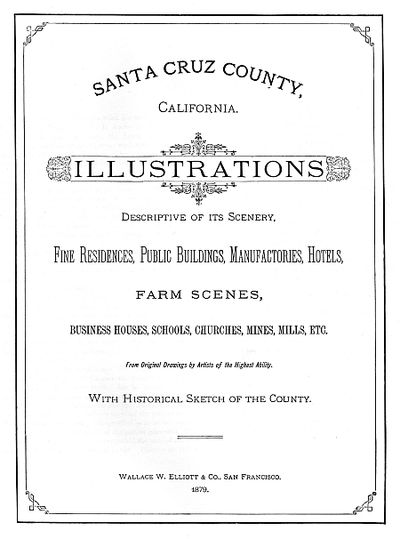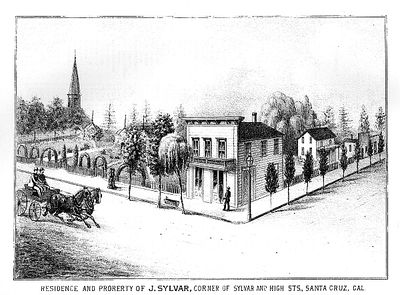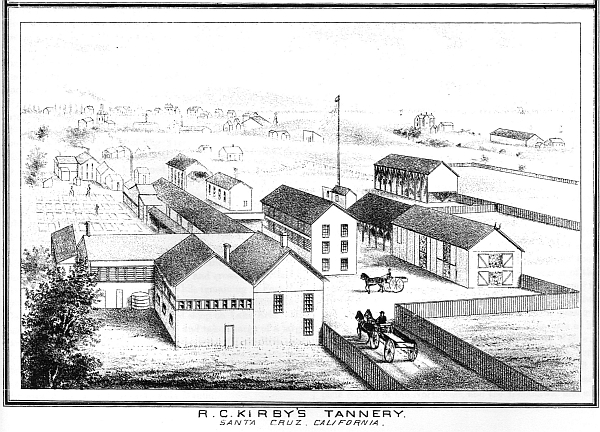History Pages: 35 - The first book on Santa Cruz history, from 1879
For a table of contents, see History pages.
Before leaving the 1870s, it’s worthwhile to note the end-of-decade appearance of a remarkable book – the first published history of Santa Cruz County. Today, the casual local history researcher has a lot of excellent source material, thanks to a group of researchers who, beginning in the 1970s, wrote the books I’m now studying and referring to for topics to blog about. These writers, in turn, were aided by an earlier group of local historians writing during a twenty-year period centered on the year 1900.
Before 1892, there was only one. W. W. Elliott published a book called Santa Cruz County, California: Illustrations with Historical Sketch, in 1879. As the title implies, the book is extensively illustrated with original drawings of people, buildings and farms, and also a few maps. We all like books with lots of pictures, so this one is a treasure.
Thanks to the efforts of the Santa Cruz Museum of Art and History, a new indexed edition of Elliott’s book was published in 1997, and can be purchased at the MAH bookstore or checked out at SCPL. In addition, Elliott’s book (with the additional 1997 research) is one of the primary sources for the biographies compiled in Santa Cruz County History Journal Number 4: Pioneers.
Photography was not yet widely used in books at that time, and these drawings are the best or only visual records we have of some of the subjects. For example, the sketch at left shows the Jackson Sylvar saloon on the upper plaza (now the corner of High and Sylvar streets). No other pictorial representations of that building are known to exist.
The second part of the title, “Historical Sketch”, must be taken with a grain of salt. There is indeed a historical “sketch”, covering the years from the Spanish explorers to about 1850. Although many inaccuracies and omissions have been revealed by later researchers, especially for the pre-American years, the brief history makes interesting reading. Following the brief section on pre-American history, longer passages deal with the Mexican-American War and the Gold Rush.
The most interesting and historically accurate parts of the book are its descriptions of the current (as of 1879) economic, educational and civic situations in the various parts of the County. Short biographies of many residents follow, making up about a third of the book. Finally, the extensive indexing added at the end by the MAH editors is very well done and adds a lot to the book’s usefulness to a modern reader.
It should be noted, however, that some prominent county residents of 1879 are omitted, presumably because they failed to contribute toward the costs of publication. A good example is the Blackburn brothers, William and Jacob. A lengthy biography of William appears in Elliott, but brother Jacob is missing. On the other hand, Jacob is profiled in Santa Cruz County History Journal Number 4 as a member of the Society of Pioneers, but William got no mention because he did not join that organization.
The publication of Santa Cruz County, California: Illustrations was financed by subscription, making it a product of what we would now call the “vanity press”. Larger subscribers apparently got more prominent placement, as can be seen in the full-page portrait of the tanner R. C. Kirby, located near the front of the book. Kirby was, of course, a prominent Santa Cruz resident, and was featured in an earlier post on this blog.
The drawing of Kirby’s tannery at the top of the Laurel Street hill, while suffering from some failures of perspective technique, is interesting not just for its capture of the tannery complex, but also for its view south down the hill toward downtown Santa Cruz and the Bay. To the right of the flag pole, in the distance you can see the S. J. Lynch house - still standing today. To the right of the Lynch house is the Davis and Cowell Lime and Cement Co. warehouse.
Sources
- L. A. Greenberg, S. D. Stevens (1997 edition), & W.W. Elliott & Co. (1879). Santa Cruz County, California: Illustrations descriptive of its scenery, fine residences, public buildings, manufactories, hotels, farm scenes, business houses, schools, churches, mines, mills, etc. ... with historical sketch of the county. Santa Cruz, Calif: Museum of Art and History at the McPherson Center.
- Stanley D. Stevens (editor), Santa Cruz County History Journal: Number 4 (1998). Santa Cruz, Calif: Art and History Museum, Santa Cruz.
Next: History Pages: 35 -


